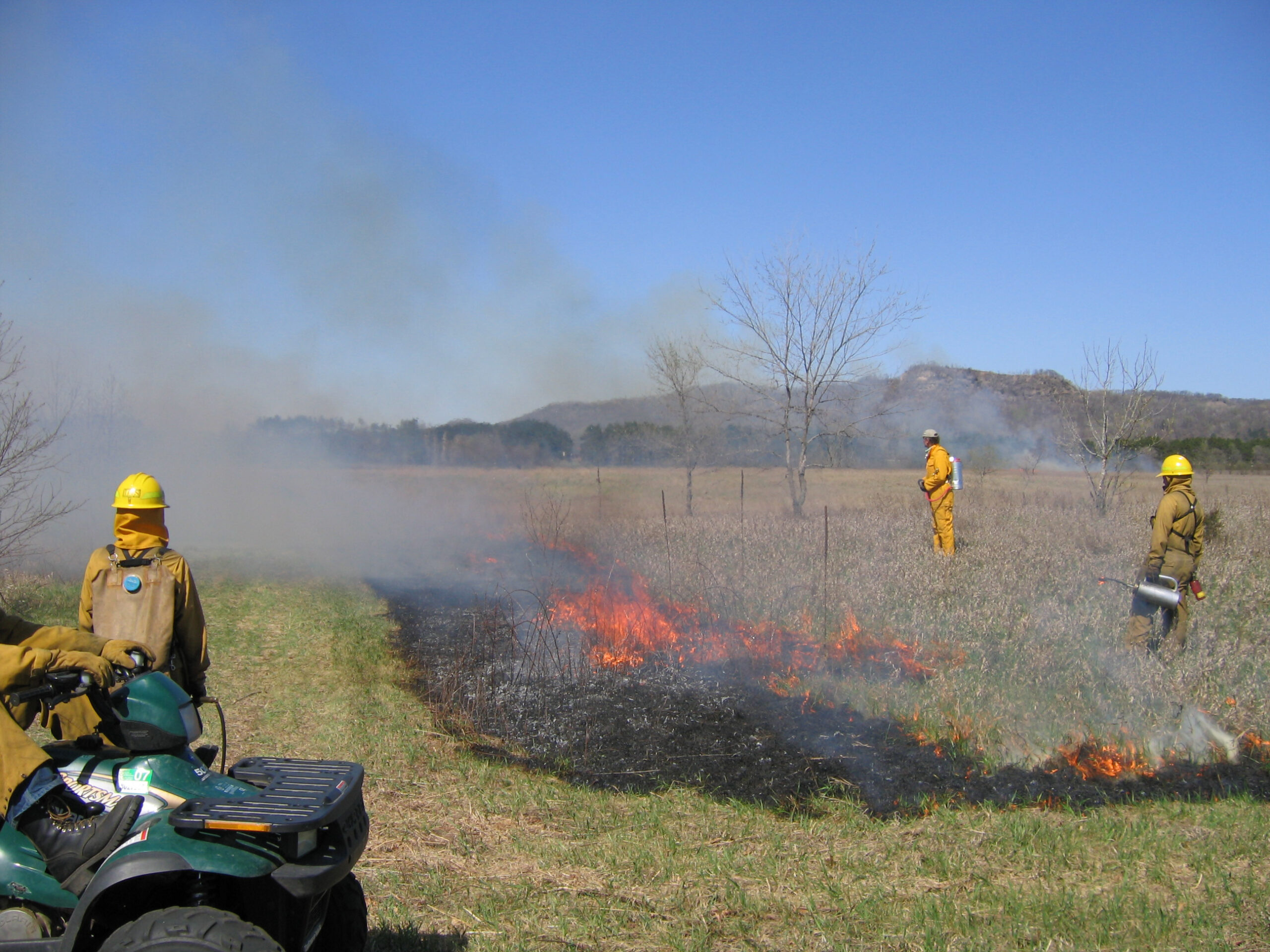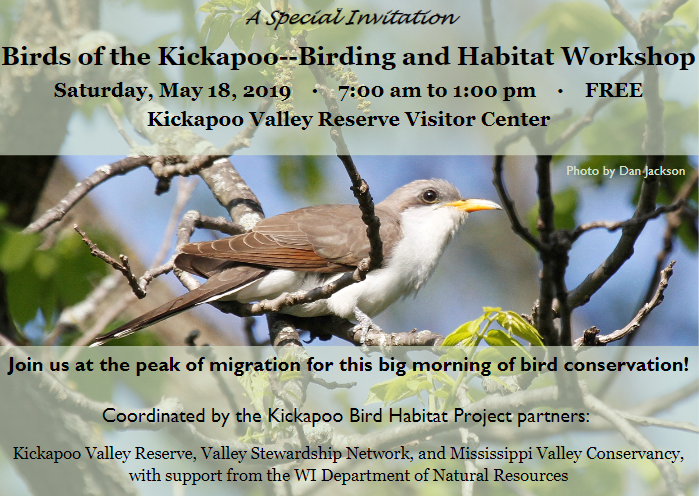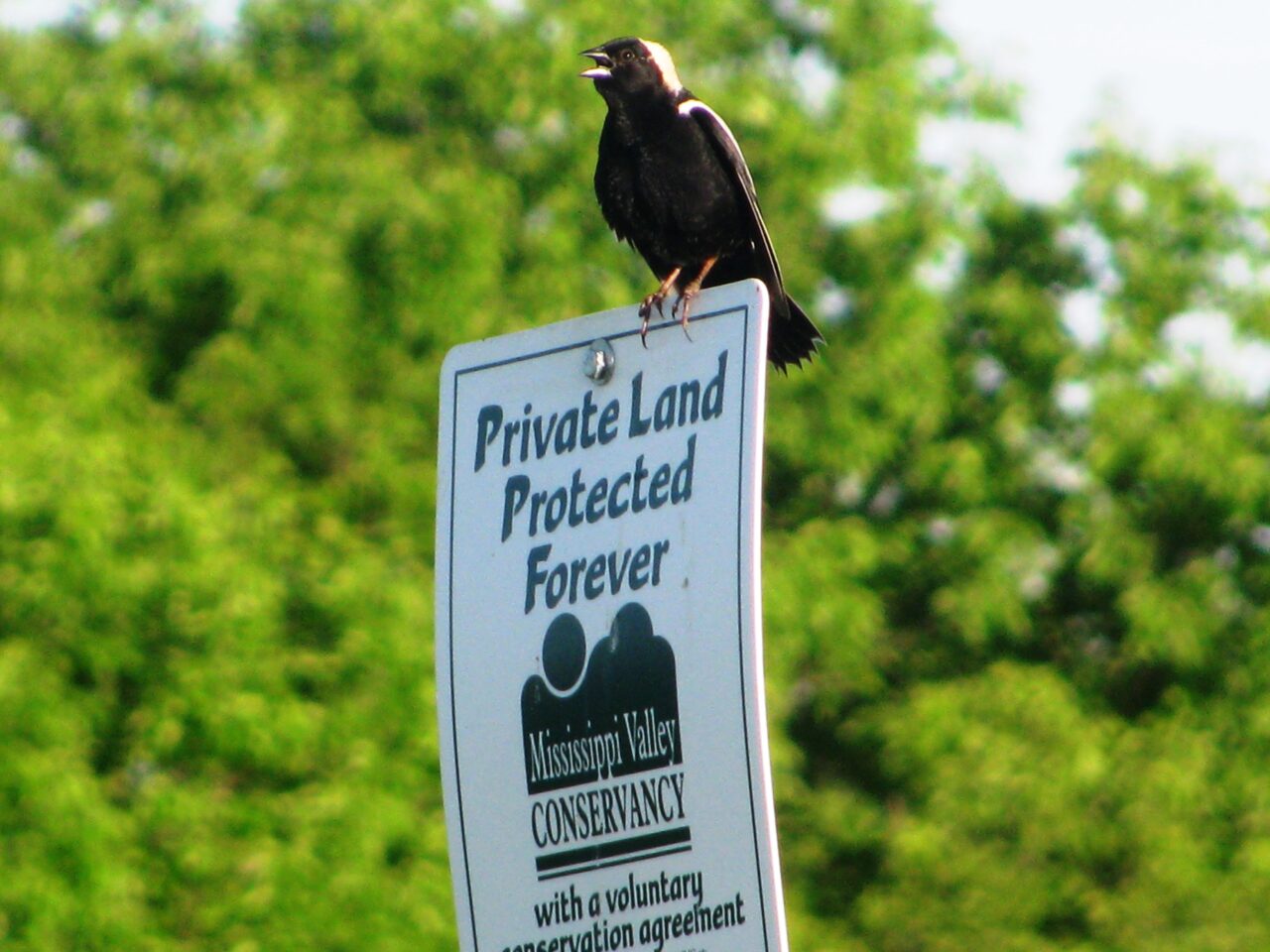Mississippi Valley Conservancy
Why Bird Conservation?
With an end goal of permanently protecting land and creating more connectivity between protected parcels, Mississippi Valley Conservancy (MVC) spearheaded a collaborative effort to establish the Kickapoo Bird Habitat Initiative (KBHI) in 2019 in partnership with the Valley Stewardship Network. With funding from the Cornell Land Trust Bird Conservation Initiative small grant program, the KBHI worked to increase awareness, improve habitat, and engage landowners in conservation practices for birds and other wildlife.
“We can only do so much on lands that we own,” notes Abbie Church, Conservation Director at MVC, a Wisconsin land trust that owns just over 5,000 acres. The greatest potential for impact on bird habitat is on privately owned lands, and holding conservation easements on about 20,000 acres means that MVC has annual opportunities to talk about bird-friendly practices when staff visits these properties during yearly easement monitoring visits.
However, helping to establish the KBHI allowed MVC to expand their outreach even further than their fee owned and easement protected properties. One component of the KBHI was to use ArcGIS, a mapping tool, to identify sites in MVC’s service area adjacent to protected lands. Outreach materials were then developed and distributed to landowners who owned property pinpointed through GIS mapping, detailing the importance of private lands for conservation impacts and offering site visits to inventory species and provide bird habitat recommendations.
Collaboration/outreach was one of three main prongs of this project; the other two were habitat management and data collection at Tunnelville Cliffs State Natural Area, a site owned by MVC. Progress is being made and efforts continue in all three areas even though the grant period is over, notes Church, who served as coordinator of the KBHI during the grant implementation period. As she says, “There’s no point when you’re finished with this work.”
Spotlight Resources: Collaborative Partnerships, Important Bird Area (IBA), GIS Mapping, eBird, Bird-focused Habitat Management
As the KBHI was being established, the team met many times to discuss building the collaboration, landowner outreach, and focal species and habitats. Together, 25 local, state, and federal conservation professionals developed plans for the initiative. KBHI collaborators included representatives from Pheasants Forever, the National Wild Turkey Federation, USFWS Partners for Fish and Wildlife, Audubon, Kickapoo Valley Reserve, and the Wisconsin Department of Natural Resources.
The KBHI team designated the core conservation area, created flyers for landowners, built a website, and sent a targeted mailing to private landowners within the Kickapoo Valley Reserve-Wildcat Mountain Important Bird Area (IBA). IBAs are areas identified as the most important areas for birds by the National Audubon Society in the U.S., and landowners were identified using GIS mapping—landowners with more than 100 acres of contiguous land or with land adjacent to protected parcels were targeted.

Project partners from both MVC and the KBHI set up one-on-one landowner site visits with those who responded to the mailing. Along with a report of existing site conditions, the team provided habitat management recommendations and potential cost-sharing resources. The goal of these meetings was to facilitate connections between private landowners and conservation professionals, as well as help landowners see how their specific land affects birds on a global scale.
Other activities supported by this grant included bird survey protocol development and bird-friendly habitat management. With only 10 staff members, MVC doesn’t have the capacity to conduct regular bird surveys. Funding from this grant allowed the KBHI to hire an accomplished birder, Michael Mossman, to conduct bird point counts and develop a breeding bird survey protocol using eBird at Tunnelville Cliffs Nature Preserve (TCNP), which established both a baseline at this MVC site and a methodology for use at other locations.
Collaborating with other partners allowed MVC to amplify its impact in a variety of ways. Habitat management at TCNP included a prescribed burn on 70 acres of grassland and forest, which was accomplished with the assistance of the Wisconsin Department of Natural Resources State Natural Areas Crew. Restoring grassland and forest at this site aimed to improve habitat for species such as the state threatened Henslow’s Sparrow, state species of special concern Red-Headed Woodpecker, and state species of concern like Bobolink, Eastern Meadowlark, and Dickcissel. TCNP now serves as a demonstration site, where private landowners and KBHI partners can observe the effects of bird-friendly habitat management.
Making the Connection

Church remembers one landowner meeting in particular. After she shared her report and recommendations with the landowner, he said something that has stayed with her since. He told her, when you look at NASA satellite imagery, you can’t even find my property; but for the birds that nest here, this little speck of dirt is so important.
Realizations like that happen one person at a time, notes Church. That’s why having the seed money to develop outreach materials and the staff capacity to reach out to individual landowners makes all the difference. “You never know when you might say something that really resonates with a landowner, and then they say it to their neighbor, and then the snowball continues,” says Church.
Advice to Other Land Trusts
By keeping the focus on end goals and leaning into partnership opportunities, Church and MVC helped to build a strong collaboration with other organizations through the KBHI. Established in 2019 as part of this grant project, the KBHI is still working to protect bird habitat in 2024; in fact, one of the primary partners in the collaboration, the Valley Stewardship Network, recently received funding through the Wisconsin Important Bird Area program to take over the coordinator role.
“It’s so easy to get bogged down in the details and spend too much time coming up with the most perfect logo and a perfect mission statement,” Church observes. “But at the end of the day, making the time to meet with landowners on site is going to affect bird populations far more than having a beautiful logo,” she believes. Also, finding funding—even just a small stipend—to help support a person to lead the effort and coordinate the partners goes a long way to sustaining these efforts over time.
Next Steps

Work on all three fronts of this project—collaboration and outreach, habitat management, and data collection—continues to this day. Now that the KBHI has a website and outreach materials, they will simply need to be updated going forward, Church notes. Having invested the time in the initial work to establish the collaboration, the KBHI has gained momentum, which they are working to maintain.
Updating their mailing list is part of that effort; their upcoming outreach efforts will be targeted towards large properties that are adjacent to Wildcat Mountain State Park and Tunnelville Cliffs Nature Preserve. MVC, and a number of private landowners, have applied for funding through the Farm Bill to continue habitat management work through prescribed burning and brush removal, and the TCNP bird survey that was conducted as a pilot project established the methodology for a bird survey that will be happening this year at Plum Creek Conservation Area, another MVC property.
True to the collaborative vision of KBHI, the same TCNP bird survey protocol was recently shared with Wildcat Mountain State Park, where a similar effort is being initiated. As Church says, “Here we are, years later, and that bird survey protocol is still being passed around and used as an example of how to kickstart bird conservation efforts.”
